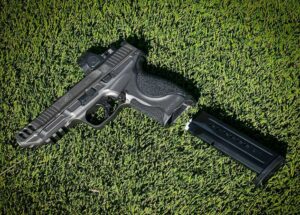
December 17, 2021
By Mark Foster, AGI Instructor
Chief District Attorney Investigator, Retired
With this month’s main article being the Sig Sauer Mosquito (GSG Firefly), I would like to continue with the rimfire train of thought and extend it to law enforcement and training.
Having spent 30 years in law enforcement from Deputy Sheriff to Chief (ground level to 20,000 ft. viewpoint), along with being a gunsmith, armorer, and a firearm instructor, I believe I can offer a cogent opinion on the subject.

Photo courtesy of Sig Sauer
Do .22 rimfires have a place in modern law enforcement training? The short answer is yes… but that answer has caveats. With the current cost and availability of ammunition, the average law enforcement agency is going to struggle with firearms training until supply chains return to normal. The expense of ammunition is not just a department problem, it is a problem that affects all of us as citizens. Taxpayer dollars are used to fund every law enforcement agency and those taxpayer dollars pay for training and ammunition. Law enforcement agencies need to use of those taxpayer dollars wisely and be accountable to their citizens. When the price of ammunition increases, agencies are left with two main choices; spend more or train less. Spending more is rarely the answer that endears any government agency to its citizens. This is not an article on problems in law enforcement, but I will tell you that lack of training is a big issue across the country. Just as you do not want officers without human or Constitution rights training, you do not want officers that are not trained properly with firearms.
Firearm skills are perishable; if you don’t train often, you lose skills and muscle memory. If you have a baseball player that sits on their butt during the off-season, they are going to play poorly and require extra work in Spring training or get cut from the team. Baseball is a game but in law enforcement when you have officers with poor training or sporadic training, it can result in problems all the way up to the loss of life… an innocent person or their own. So, if an agency can train with cheaper rimfire ammunition, they can get the training more cost effectively. I used to tell my officers that I never wanted to be on the 6 o’clock news because I failed to spend a few hundred dollars to prevent a foreseeable problem.
I mentioned caveats. One caveat includes purchasing rimfire adapters or dedicated rimfire weapons, such as handguns like the Mosquito (Firefly), Glock 44 (.22LR), or rifles like the Smith and Wesson M&P 15-22. The cost would not be outrageous because agencies would not have to purchase a rimfire weapon for every department member, just enough to outfit a typical training session. Another caveat is realism. Rimfire ammunition does not have the same recoil as full-sized cartridges. I believe that is a potential positive rather than a negative, in that it allows officers to train with more control and eliminating “flinching” caused by heavy recoil. Another positive is reduced noise. While hearing protection is still required, the natural noise is significantly reduced and thereby causing less harm to officers. Hearing loss is real and anything that can be done to reduce it is a positive.

Glock Model 44 .22 rimfire. Photo courtesy of Glock, Inc.
The use of rimfire adapters lessens the cost of equipment even further. There are rimfire adapters (slides and magazines) for the most common law enforcement handguns, including Glock, Sig, Beretta, Springfield, and CZ. Purchasing enough adapter kits for a typical training session could significantly cut the cost of equipment needed. There are adapters for AR-15 type rifles, such as the kit from CMMG, which allow for use of rimfire ammunition in a standard duty rifle. While the kits work great, there are some issues that arise from rifle adapters involving lead and cleaning. Rimfire ammunition generally uses lead bullets that are not jacketed (the military has used special purpose jacketed rimfire ammunition). This can cause problems in a gas operated rifle if lead is allowed to build up around the gas port. The lead also builds up in the barrel rifling significantly faster than with jacketed bullets, so more frequent and thorough cleaning is required. Strictly my opinion but I think a dedicated rimfire rifle, such as the S&W M&P 15-22, is the better way to go.
So, with the current cost of ammunition and the limited availability of component materials, the use of rimfire ammunition and firearms could be a problem-solving solution for law enforcement. There are other potential solutions, such as laser and computer simulators. Simulators are fun but can be very expensive, but despite how much fun they can be, live fire training is always taken more seriously… which should be a key point of any training. Is the use of .22 rimfire the ultimate solution to firearms training? Do me a favor and doubt anyone that tells you there is a single best solution! The use of .22 rimfires for training is something I believe to be a viable option for many law enforcement agencies and something definitely worth considering.

Smith & Wesson M&P 15-22 rifle. Photo courtesy of Smith & Wesson



